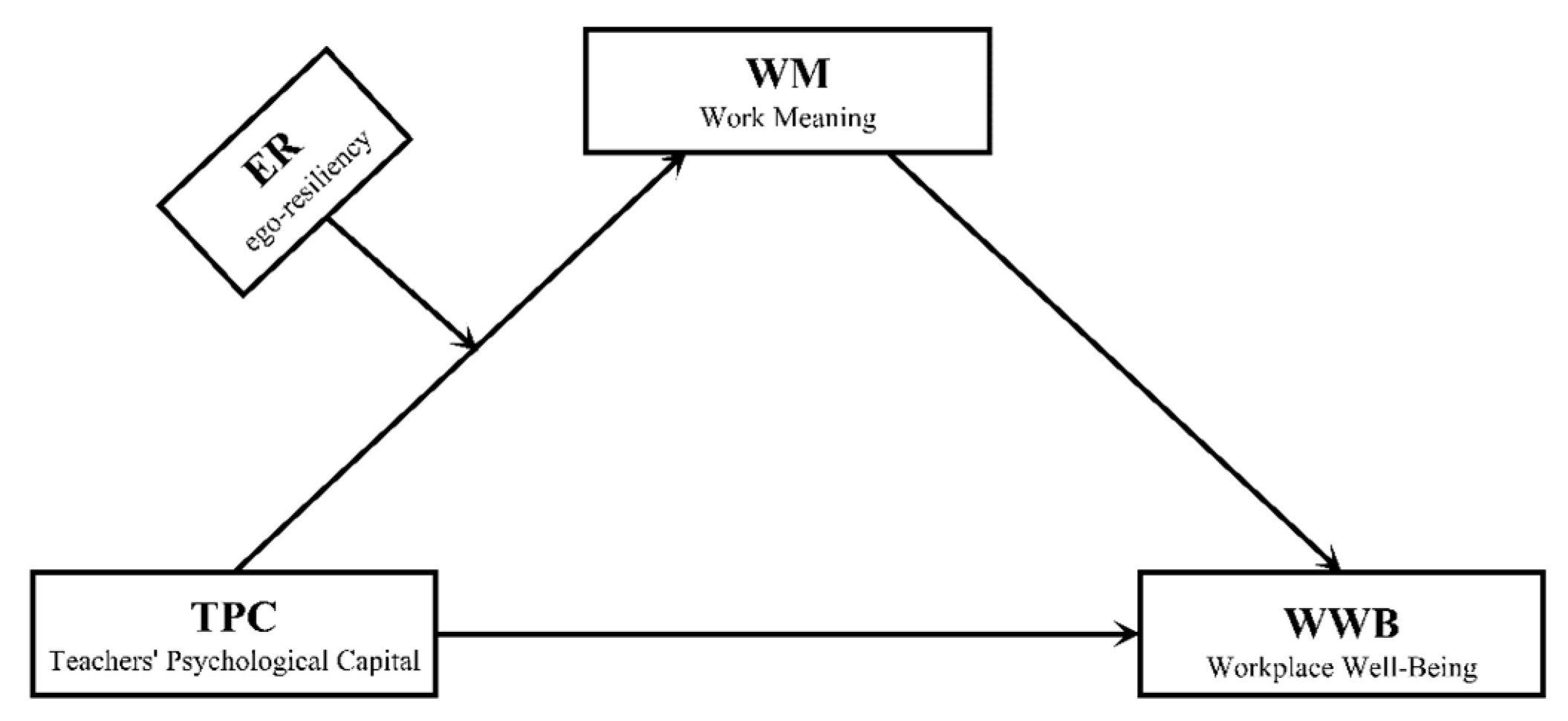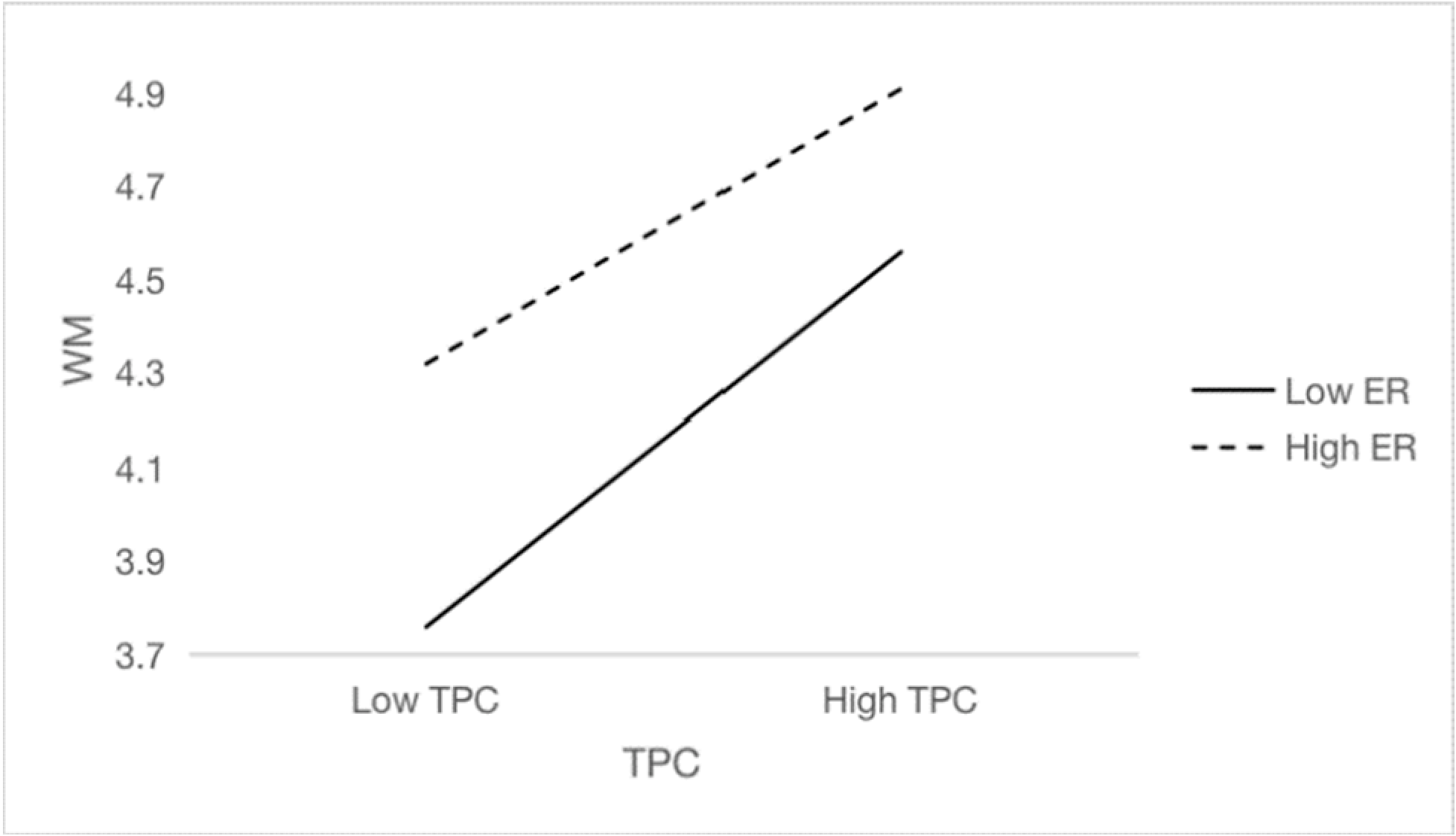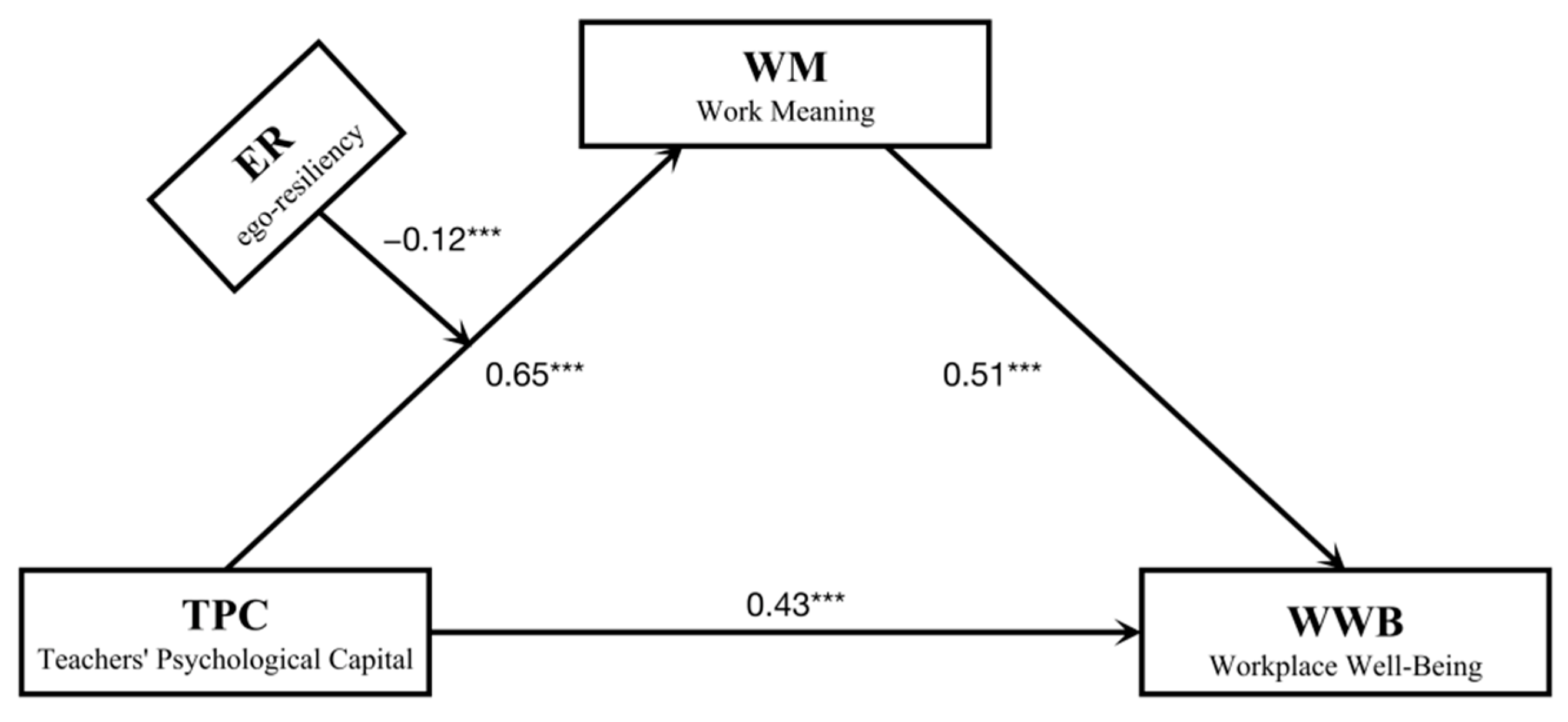How Does Teachers’ Psychological Capital Influence Workplace Well-Being? A Moderated Mediation Model of Ego-Resiliency and Work-Meaning Cognition
Abstract
1. Introduction
1.1. The Importance of Workplace Well-Being for Teachers
1.2. Teachers’ Psychological Capital and Workplace Well-Being
1.3. Teachers’ Psychological Capital, Work-Meaning Cognition, and Workplace Well-Being
1.4. Teachers’ Psychological Capital, Ego-Resiliency, Work-Meaning Cognition, and Workplace Well-Being
1.5. Purpose of the Present Study
2. Method
2.1. Sample
2.2. Instrument
2.3. Data Analysis
3. Results
3.1. Common Method Bias
3.2. Correlation Statistics
3.3. Model of Work-Meaning Cognition as a Mediator
3.4. Testing the Moderated Mediation Model
4. Discussion
4.1. Relationship between Teachers’ Psychological Capital and Workplace Well-Being
4.2. The Mediating Role of Work-Meaning Cognition
4.3. The Moderating Role of Ego-Resiliency
4.4. Limitations and Future Research
4.5. Implications
5. Conclusions
Author Contributions
Funding
Institutional Review Board Statement
Informed Consent Statement
Data Availability Statement
Acknowledgments
Conflicts of Interest
References
- Bhardwaj, A. Importance of education in human life: A holistic approach. Int. J. Sci. Conscious. 2016, 2, 23–28. [Google Scholar]
- Johansson, B.; Fogelberg-Dahm, M.; Wadensten, B. Evidence-based practice: The importance of education and leadership. J. Nurs. Manag. 2010, 18, 70–77. [Google Scholar] [CrossRef] [PubMed]
- Jetton, T.L.; Alexander, P.A. Instructional Importance: What Teachers Value and What Students Learn. Read. Res. Q. 1997, 32, 290–308. [Google Scholar] [CrossRef]
- Becker, E.S.; Goetz, T.; Morger, V.; Ranellucci, J. The importance of teachers’ emotions and instructional behavior for their students’ emotions—An experience sampling analysis. Teach. Teach. Educ. 2014, 43, 15–26. [Google Scholar] [CrossRef]
- Mainhard, T.; Oudman, S.; Hornstra, L.; Bosker, R.J.; Goetz, T. Student emotions in class: The relative importance of teachers and their interpersonal relations with students. Learn. Instr. 2018, 53, 109–119. [Google Scholar] [CrossRef]
- Glazzard, J.; Rose, A. The impact of teacher well-being and mental health on pupil progress in primary schools. J. Public Ment. Health 2019, 19, 349–357. [Google Scholar] [CrossRef]
- Gray, C.; Wilcox, G.; Nordstokke, D. Teacher mental health, school climate, inclusive education and student learning: A review. Can. Psychol. Can. 2017, 58, 203–210. [Google Scholar] [CrossRef]
- Martin, A.J.; Strnadová, I.; Němec, Z.; Hájková, V.; Květoňová, L. Teacher assistants working with students with disability: The role of adaptability in enhancing their workplace wellbeing. Int. J. Incl. Educ. 2021, 25, 565–587. [Google Scholar] [CrossRef]
- Cassidy, D.J.; King, E.K.; Wang, Y.C.; Lower, J.K.; Kintner-Duffy, V.L. Teacher work environments are toddler learning environments: Teacher professional well-being, classroom emotional support, and toddlers’ emotional expressions and behaviours. Early Child Dev. Care 2016, 187, 1666–1678. [Google Scholar] [CrossRef]
- Zheng, X.; Zhu, W.; Zhao, H.; Zhang, C. Employee well-being in organizations: Theoretical model, scale development, and cross-cultural validation. J. Organ. Behav. 2015, 36, 621–644. [Google Scholar] [CrossRef]
- Jones, C.; Hadley, F.; Waniganayake, M.; Johnstone, M. Find your tribe! Early childhood educators defining and identifying key factors that support their workplace wellbeing. Australas. J. Early Child. 2019, 44, 326–338. [Google Scholar] [CrossRef]
- Jerrim, J.; Sims, S. When is high workload bad for teacher wellbeing? Accounting for the non-linear contribution of specific teaching tasks. Teach. Teach. Educ. 2021, 105, 103395. [Google Scholar] [CrossRef]
- You, C. A Research on the Current Situation and Countermeasures of Young College Teachers’ Professional Well-being. Adult High. Educ. 2022, 4, 1–6. [Google Scholar] [CrossRef]
- Fedorov, A.; Ilaltdinova, E.; Frolova, S. Teachers’ Professional Well-Being: State and Factors. Univers. J. Educ. Res. 2020, 8, 1698–1710. [Google Scholar] [CrossRef]
- Burchinal, M.; Howes, C.; Pianta, R.; Bryant, D.; Early, D.; Clifford, R.; Barbarin, O. Predicting Child Outcomes at the End of Kindergarten from the Quality of Pre-Kindergarten Teacher–Child Interactions and Instruction. Appl. Dev. Sci. 2008, 12, 140–153. [Google Scholar] [CrossRef]
- Mashburn, A.J.; Pianta, R.C.; Hamre, B.K.; Downer, J.T.; Barbarin, O.A.; Bryant, D.; Burchinal, M.; Early, D.M.; Howes, C. Measures of Classroom Quality in Prekindergarten and Children’s Development of Academic, Language, and Social Skills. Child Dev. 2008, 79, 732–749. [Google Scholar] [CrossRef]
- Morris, C.A.S.; Denham, S.A.; Bassett, H.H.; Curby, T.W. Relations Among Teachers’ Emotion Socialization Beliefs and Practices and Preschoolers’ Emotional Competence. Early Educ. Dev. 2013, 24, 979–999. [Google Scholar] [CrossRef]
- Wessels, E.; Wood, L. Fostering teachers’ experiences of well-being: A participatory action learning and action research approach. South Afr. J. Educ. 2019, 39, 1–10. [Google Scholar] [CrossRef]
- Collie, R.J.; Shapka, J.D.; Perry, N.E.; Martin, A.J. Teacher well-being: Exploring its components and a practice-oriented scale. J. Psychoeduc. Assess. 2015, 33, 744–756. [Google Scholar] [CrossRef]
- Kiltz, L.; Rinas, R.; Daumiller, M.; Fokkens-Bruinsma, M.; Jansen, E.P.W.A. ‘When They Struggle, I Cannot Sleep Well Either’: Perceptions and Interactions Surrounding University Student and Teacher Well-Being. Front. Psychol. 2020, 11, 2283. [Google Scholar] [CrossRef]
- Xu, Q.; Hou, Z.; Zhang, C.; Yu, F.; Li, T. Career Capital and Well-Being: A Configurational Perspective. Int. J. Environ. Res. Public Health 2022, 19, 10196. [Google Scholar] [CrossRef] [PubMed]
- Youssef-Morgan, C.M.; Luthans, F. Psychological capital and well-being. Stress Health J. Int. Soc. Investig. Stress 2015, 31, 180–188. [Google Scholar] [CrossRef]
- Rabenu, E.; Yaniv, E.; Elizur, D. The Relationship between Psychological Capital, Coping with Stress, Well-Being, and Performance. Curr. Psychol. 2017, 36, 875–887. [Google Scholar] [CrossRef]
- Luthans, F.; Avolio, B.J.; Avey, J.B.; Norman, S.M. Positive psychological capital: Measurement and relationship with performance and satisfaction. Pers. Psychol. 2007, 60, 541–572. [Google Scholar] [CrossRef]
- Çavus, M.F.; Gökçen, A. Psychological Capital: Definition, Components and Effects. Br. J. Educ. Soc. Behav. Sci. 2015, 5, 244–255. [Google Scholar] [CrossRef]
- Ma, L.; Zhou, F.; Liu, H. Relationship Between Psychological Empowerment and the Retention Intention of Kindergarten Teachers: A Chain Intermediary Effect Analysis. Front. Psychol. 2021, 12, 601992. [Google Scholar] [CrossRef] [PubMed]
- Xu, J.; Liu, Y.; Chung, B. Leader psychological capital and employee work engagement: The roles of employee psychological capital and team collectivism. Leadersh. Organ. Dev. J. 2017, 38, 969–985. [Google Scholar] [CrossRef]
- Demir, S. The Relationship between Psychological Capital and Stress, Anxiety, Burnout, Job Satisfaction, and Job Involvement. Eurasian J. Educ. Res. 2018, 75, 137–153. [Google Scholar]
- Weiner, B. Human Motivation: Metaphors, Theories, and Research; Sage: London, UK, 1992. [Google Scholar]
- Mahfud, T.; Triyono, M.B.; Sudira, P.; Mulyani, Y. The influence of social capital and entrepreneurial attitude orientation on entrepreneurial intentions: The mediating role of psychological capital. Eur. Res. Manag. Bus. Econ. 2020, 26, 33–39. [Google Scholar] [CrossRef]
- Schürmann, L.; Gaschler, R.; Quaiser-Pohl, C. Motivation theory in the school context: Differences in preservice and practicing teachers’ experience, opinion, and knowledge. Eur. J. Psychol. Educ. 2021, 36, 739–757. [Google Scholar] [CrossRef]
- Steger, M.F.; Dik, B.J.; Duffy, R.D. Measuring meaningful work: The work and meaning inventory (WAMI). J. Career Assess. 2012, 20, 322–337. [Google Scholar] [CrossRef]
- Janicke-Bowles, S.H.; Rieger, D.; Connor, W. Finding Meaning at Work: The Role of Inspiring and Funny YouTube Videos on Work-Related Well-Being. J. Happiness Stud. 2019, 20, 619–640. [Google Scholar] [CrossRef]
- Shiri, S.; Wexler, I.; Marmor, A.; Meiner, Z.; Schwartz, I.; Korach, O.L.; Azoulay, D. Hospice Care: Hope and Meaning in Life Mediate Subjective Well-Being of Staff. Am. J. Hosp. Palliat. Med. 2020, 37, 785–790. [Google Scholar] [CrossRef] [PubMed]
- Wieneke, K.C.; Egginton, J.S.; Jenkins, S.M.; Kruse, G.C.; Lopez-Jimenez, F.; Mungo, M.M.; Riley, B.A.; Limburg, P.J. Well-Being Champion Impact on Employee Engagement, Staff Satisfaction, and Employee Well-Being. Mayo Clin. Proc. Innov. Qual. Outcomes 2019, 3, 106–115. [Google Scholar] [CrossRef] [PubMed]
- Masten, A.S. Ordinary magic: Resilience processes in development. Am. Psychol. 2001, 56, 227–238. [Google Scholar] [CrossRef]
- Kubo, T.; Sugawara, D.; Masuyama, A. The effect of ego-resiliency and COVID-19-related stress on mental health among the Japanese population. Pers. Individ. Differ. 2021, 175, 110702. [Google Scholar] [CrossRef]
- Taylor, Z.E.; Eisenberg, N.; VanSchyndel, S.K.; Eggum-Wilkens, N.D.; Spinrad, T.L. Children’s negative emotions and ego-resiliency: Longitudinal relations with social competence. Emotion 2014, 14, 397–406. [Google Scholar] [CrossRef]
- Park, I.-S.; Shin, H.-J. The Effects of Ego-resiliency Enhancing Program on Ego-resiliency and Empathy of Pre-service Early Childhood Teachers. J. Futur. Early Child. Educ. 2017, 24, 151–170. [Google Scholar] [CrossRef]
- Lee, W.S.; Shim, S.Y. Structural equation modeling on early childhood teachers’ emotional labor, ego resiliency, job satisfaction. J. Child. Educ. (SCE) 2014, 23, 337–354. [Google Scholar]
- Goryczka, A.; Dębski, P.; Gogola, A.M.; Gorczyca, P.; Piegza, M. Depressive and Anxiety Symptoms and Their Relationships with Ego-Resiliency and Life Satisfaction among Well-Educated, Young Polish Citizens during the COVID-19 Pandemic. Int. J. Environ. Res. Public Health 2022, 19, 10364. [Google Scholar] [CrossRef]
- Steger, M.F.; Kashdan, T.B.; Sullivan, B.A.; Lorentz, D. Understanding the search for meaning in life: Personality, cognitive style, and the dynamic between seeking and experiencing meaning. J. Personal. 2008, 76, 199–228. [Google Scholar] [CrossRef] [PubMed]
- Hong, M.K. The Impact of the University Student’s Self-Leadership on the Learning Flow: Focused on Mediating Effect of Psychological Capital. J. Bus. Educ. 2015, 29, 1–23. [Google Scholar]
- Jeong, J.A. A Study on the Effects of Positive Psychological Capital on Satisfaction in Major and Career Plan: Focused on Department of Airline Services. J. Korea Serv. Manag. Soc. 2017, 18, 217–244. [Google Scholar] [CrossRef]
- Saleem, M.S.; Isha, A.S.N.; Yusop, Y.M.; Awan, M.I.; Naji, G.M.A. The Role of Psychological Capital and Work Engagement in Enhancing Construction Workers’ Safety Behavior. Front. Public Health 2022, 10, 810145. [Google Scholar] [CrossRef] [PubMed]
- Asadollahi, A.; Karimpoor, L.; Kaveh, M.H.; Ghahremani, L. Effectiveness of resilience training intervention on psychological capital of the underprivileged widowed women of Fasa City, Iran. BMC Women’s Health 2022, 22, 302. [Google Scholar] [CrossRef]
- Jalil, M.F.; Ali, A.; Ahmed, Z.; Kamarulzaman, R. The Mediating Effect of Coping Strategies Between Psychological Capital and Small Tourism Organization Resilience: Insights From the COVID-19 Pandemic, Malaysia. Front. Psychol. 2021, 12, 766528. [Google Scholar] [CrossRef]
- Deci, E.L.; Ryan, R.M. The “What” and “Why” of Goal Pursuits: Human Needs and the Self-Determination of Behavior. Psychol. Inq. 2000, 11, 319–333. [Google Scholar] [CrossRef]
- Šakan, D.; Žuljević, D.; Rokvić, N. The role of basic psychological needs in well-being during the COVID-19 outbreak: A self-determination theory perspective. Front. Public Health 2020, 8, 583181. [Google Scholar] [CrossRef]
- Zhang, W. Development and Characteristic Analysis of Psychological Capital Questionnaire for Primary and Secondary School Teachers; Southwest University: El Paso, TX, USA, 2010. [Google Scholar]
- Zhou, X.Y.; Peng, X.T.; Fu, Y.Q.; Zhang, Z.X. The relationship between psychological empowerment and preschool teachers’ job burnout: Analysis of chain mediation effect. Chin. J. Clin. Psychol. 2019, 27, 1049–1053. [Google Scholar]
- Miao, R.; Cao, Y. High-Performance Work System, Work Well-Being, and Employee Creativity: Cross-Level Moderating Role of Transformational Leadership. Int. J. Environ. Res. Public Health 2019, 16, 1640. [Google Scholar] [CrossRef]
- Spreitzer, G.M. Psychological Empowerment in the Workplace: Dimensions, Measurement, and Validation. Acad. Manag. J. 1995, 38, 1442–1465. [Google Scholar] [CrossRef]
- Wang, Z.; Song, M.; Wang, C.F.; Xu, H.Y. How Does Ethical Leadership Behavior Influence Follower Feedback Avoidance Behavior: The Mediating Roles of Leader-Member Exchange and Meaning of Work. Chin. J. Manag. 2015, 1, 96–102. [Google Scholar]
- Block, J.; Kremen, A.M. IQ and ego-resiliency: Conceptual and empirical connections and separateness. J. Pers. Soc. Psychol. 1996, 70, 349–361. [Google Scholar] [CrossRef] [PubMed]
- Kunzler, A.M.; Helmreich, I.; Chmitorz, A.; König, J.; Binder, H.; Wessa, M.; Lieb, K. Psychological interventions to foster resilience in healthcare professionals. Cochrane Database Syst. Rev. 2020. [Google Scholar] [CrossRef]
- Hartmann, S.; Weiss, M.; Newman, A.; Hoegl, M. Resilience in the Workplace: A Multilevel Review and Synthesis. Appl. Psychol. 2020, 69, 913–959. [Google Scholar] [CrossRef]
- Bi, D.T.; Cao, R. Analysis of Factors that Influence Researchers’ Data Literacy Using SEM and fsQCA. J. China Soc. Sci. Technol. Inf. 2021, 40, 11–20. [Google Scholar]
- Hayes, A.F. Mediation, Moderation, and Conditional Process Analysis. Introduction to Mediation, Moderation, and Conditional Process Analysis: A Regression-Based Approach Edition; Guilford Publications: New York, NY, USA, 2013; Volume 1, p. 20. [Google Scholar]
- Luthans, K.W.; Luthans, B.C.; Palmer, N.F. A positive approach to management education. J. Manag. Dev. 2016, 35, 1098–1118. [Google Scholar] [CrossRef]
- Avey, J.B.; Luthans, F.; Jensen, S.M. Psychological capital: A positive resource for combating employee stress and turnover. Hum. Resour. Manag. 2009, 48, 677–693. [Google Scholar] [CrossRef]
- Roberts, S.J.; Scherer, L.L.; Bowyer, C.J. Job Stress and Incivility. J. Leadersh. Organ. Stud. 2011, 18, 449–458. [Google Scholar] [CrossRef]
- Spence Laschinger, H.K.; Fida, R. New nurses burnout and workplace wellbeing: The influence of authentic leadership and psychological capital. Burn. Res. 2014, 1, 19–28. [Google Scholar] [CrossRef]
- Gupta, M.; Shaheen, M. Does work engagement enhance general well-being and control at work? Mediating role of psychological capital. Evid.-Based HRM Glob. Forum Empir. Sch. 2018, 6, 272–286. [Google Scholar] [CrossRef]
- Nguyen, T.D.; Nguyen, T.T.M. Psychological Capital, Quality of Work Life, and Quality of Life of Marketers. J. Macromarketing 2012, 32, 87–95. [Google Scholar] [CrossRef]
- Alkahtani, N.S.; Sulphey, M.M.; Delany, K.; Adow, A.H.E. The influence of psychological capital on workplace well-being and employee engagement among Saudi workforce. Humanit. Soc. Sci. Rev. 2020, 8, 233–245. [Google Scholar] [CrossRef]
- Afzal, S.; Din, M.; Malik, H.D. Psychological Capital as an Index of Workplace Flourishing of College Faculty Members. J. Educ. Res. 2020, 23, 91. [Google Scholar]
- Pratt, M.G.; Ashforth, B.E. Fostering meaningfulness in working and at work. Posit. Organ. Scholarsh. Found. New Discip. 2003, 309, 327. [Google Scholar]
- Seligman, M.E. Flourish: A Visionary New Understanding of Happiness and Well-Being; Free Press: New York, NY, USA, 2012. [Google Scholar]
- Goh, P.S.; Goh, Y.W.; Jeevanandam, L.; Nyolczas, Z.; Kun, A.; Watanabe, Y.; Noro, I.; Wang, R.; Jiang, J. Be happy to be successful: A mediational model of PERMA variables. Asia Pac. J. Hum. Resour. 2022, 60, 632–657. [Google Scholar] [CrossRef]
- Sirgy, M.J. Work Well-being. Psychol. Qual. Life 2021, 83, 373–409. [Google Scholar] [CrossRef]
- Hobfoll, S.E.; Halbesleben, J.; Neveu, J.-P.; Westman, M. Conservation of Resources in the Organizational Context: The Reality of Resources and Their Consequences. Annu. Rev. Organ. Psychol. Organ. Behav. 2018, 5, 103–128. [Google Scholar] [CrossRef]
- Iqbal, Q.; Piwowar-Sulej, K. Sustainable Leadership, Environmental Turbulence, Resilience, and Employees’ Wellbeing in SMEs. Front. Psychol. 2022, 13, 1–13. [Google Scholar] [CrossRef]



| Attribute | Frequency | Proportion% | |
|---|---|---|---|
| Gender | Male | 387 | 27.90% |
| Female | 1001 | 72.10% | |
| Education | Below undergraduate | 126 | 9.08% |
| Undergraduate and above | 1262 | 90.92% | |
| Teaching grade | Kindergarten | 148 | 10.84% |
| Primary school | 768 | 56.26% | |
| Middle school | 300 | 21.98% | |
| High school | 149 | 10.92% | |
| Attribute | All (Frequency) | Mean | SD |
| Age | 1384 | 39.40 | 8.84 |
| Working experience (year) | 1294 | 17.93 | 10.09 |
| M | SD | 1 | 2 | 3 | 4 | |
|---|---|---|---|---|---|---|
| 1. TPC | 4.77 | 0.76 | 1 | — | — | — |
| 2. ER | 3.15 | 0.56 | 0.60 ** | 1 | — | — |
| 3. WM | 4.36 | 0.74 | 0.66 ** | 0.59 ** | 1 | — |
| 4. WWB | 4.15 | 0.77 | 0.74 ** | 0.63 ** | 0.76 ** | 1 |
| Criterion | Predictors | R | R2 | F | β | Boot LLCI | Boot ULCI | t |
|---|---|---|---|---|---|---|---|---|
| WM | TPC | 0.66 | 0.43 | 1061.17 *** | 0.65 | 0.61 | 0.68 | 32.58 *** |
| WWB | TPC | 0.82 | 0.68 | 1457.91 *** | 0.43 | 0.39 | 0.47 | 20.49 *** |
| WM | 0.51 | 0.47 | 0.55 | 24.10 *** |
| Predictors | Criterion | |||||||
|---|---|---|---|---|---|---|---|---|
| WM(M) | WWB(Y) | |||||||
| β | SE | p | 95% CI | β | SE | p | 95% CI | |
| TPC(X) | 0.65 | 0.02 | <0.001 | [0.61, 0.68] | 0.43 | 0.02 | <0.001 | [0.39, 0.47] |
| WM(M) | — | — | — | — | 0.51 | 0.02 | <0.001 | [0.47, 0.55] |
| ER(W) | 1.00 | 0.16 | <0.001 | [0.69, 1.32] | — | — | — | — |
| X × W | −0.12 | 0.33 | <0.001 | [−0.19, −0.06] | — | — | — | — |
| R2 = 0.706, F (3, 1384) = 458.56, p < 0.001 | R2 = 0.823, F (2, 1385) = 1457.91, p < 0.001. | |||||||
Publisher’s Note: MDPI stays neutral with regard to jurisdictional claims in published maps and institutional affiliations. |
© 2022 by the authors. Licensee MDPI, Basel, Switzerland. This article is an open access article distributed under the terms and conditions of the Creative Commons Attribution (CC BY) license (https://creativecommons.org/licenses/by/4.0/).
Share and Cite
Sun, B.; Guo, H.; Xu, L.; Ding, F. How Does Teachers’ Psychological Capital Influence Workplace Well-Being? A Moderated Mediation Model of Ego-Resiliency and Work-Meaning Cognition. Int. J. Environ. Res. Public Health 2022, 19, 14730. https://doi.org/10.3390/ijerph192214730
Sun B, Guo H, Xu L, Ding F. How Does Teachers’ Psychological Capital Influence Workplace Well-Being? A Moderated Mediation Model of Ego-Resiliency and Work-Meaning Cognition. International Journal of Environmental Research and Public Health. 2022; 19(22):14730. https://doi.org/10.3390/ijerph192214730
Chicago/Turabian StyleSun, Binghai, Hongteng Guo, Luyun Xu, and Fujun Ding. 2022. "How Does Teachers’ Psychological Capital Influence Workplace Well-Being? A Moderated Mediation Model of Ego-Resiliency and Work-Meaning Cognition" International Journal of Environmental Research and Public Health 19, no. 22: 14730. https://doi.org/10.3390/ijerph192214730
APA StyleSun, B., Guo, H., Xu, L., & Ding, F. (2022). How Does Teachers’ Psychological Capital Influence Workplace Well-Being? A Moderated Mediation Model of Ego-Resiliency and Work-Meaning Cognition. International Journal of Environmental Research and Public Health, 19(22), 14730. https://doi.org/10.3390/ijerph192214730





